| Garbo stories on her best films
- By Néstor G. Acevedo Greg -
 |
|
|
| |
| |
| ANNA CHRISTIE 1930

“Gimme a viskey, chincher ale on the side and don't be stingy, baybee” were the first words uttered on the screen by Greta Garbo in the film version of Eugene O'Neill's Pulitzer Prize 1921, Anna Christie 1930.
Garbo's first talkie film.
MGM selected this film for Garbo's sound debut because the title character is Swedish and would therefore have an accent like her's. “Her voice”, wrote Richard Watts Jr. of the New York Herald Tribune, "is revealed as a deep, husky, throaty contralto that possesses every bit of that fabulous poetic glamour that has made this distant Swedish lady, the outstanding actress of the motion picture World.”
Anna Christie was an artistic triumph and a commercial success. Critics, audiences and studio executives alike were enthralled with Garbo's performance, which earned her a nomination for an Academy Award. Garbo, unlike so many stars of silent films, made the transition to talkies with style and grace.
Garbo's original contract with MGM had no provision for talkies. Through it was standard procedure to sign a talk agreement; Garbo had declined because of her lack of confidence in her English language skills. The death of the silent film era made her reconsiders her position.
Louis B. Mayer eased the transition for her by promising that she could do a version of the film in German, a language she was more comfortable with, if she would do the English version first.
In those days, films were neither dubbed nor subtitled. Rather, a number of versions in various languages were prepared for distribution in foreign markets.
What the critics said:
Picture Play
The Voice that shook the world! It's Greta Garbo's, of course, and for the life, we can't decide whether it's a baritone or bass. She makes it heard for the first time on the screen in Anna Christie, and there isn't another like it. Disturbing, incongruous, its individuality is so pronounced that it would belong to no one less strongly individual than Garbo herself. In choosing Anna Christie for her audible debut, the Swedish star attempts one of her most difficult roles in the contemporary theater. The part is almost a monologue, a test for an actress experienced in speech, a brave feat for one who is not. Garbo makes a magnificent effort, a gallant fight against great odds. For she can do no wrong.
New York Times
The tall Swedish actress's portrayal of the title role of Anna Christie is one that is very true to life. Miss Garbo, being of the same nationality as Anna, gives an enlightening conception of the character. All this is splendidly acted by Miss Garbo who proves here that she can handle a forceful role with little or no relief in its dull atmosphere just as well as she can play the part of the fashionably dressed, romantic wife of a moneyed lawyer.
|
| |
| ROMANCE 1930
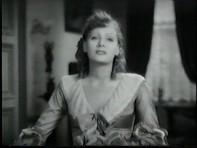
In Greta Garbo's second talkie, Romance (1930), she received the best MGM studios had to offer: the best directors, set designers, costumes and so on. Romance once again found Garbo under the skillful direction of Clarence Brown and William Daniels, one of the most brilliant cinematographers in the history of American film industry. He was assigned to most of Garbo films. He was; in fact, know as “Garbo's cameraman” throughout the 30's.
In addition to capturing her luminescent beauty on film, he was able to win her trust and accorded her with preferential treatment, insisting that her scenes be shot on closed sets with only essential personnel allowed. Romance is the story of a worldly opera Diva and an innocent rector.
Gordon Gavin (this actor commits suicide) who falls in love with Rita, Garbo's role, but ultimately refuses to succumb to temptation. MGM has a mature leading man, Lewis Stone; Garbo admired Stone immensely and appeared with him in seven films, this one included, which is the most often she costarred with any one actor. Garbo received her second nomination to The Academy Award for her performance in this film. ( her first nomination was Anna Christie (1930)
What the critics said:
Picture Play
Hollywood's favorite adjective “marvelous” is the word that first comes to mind on viewing Greta Garbo in Romance. Her performance is a thing of pure beauty, an inspiring blend of intellect and emotion, a tender, poignant, poetic portrait of a woman who thrusts love from her because she considers herself unworthy of the man who offers it. Garbo's inescapable magnetism, her sure intelligence, her clear, unflagging talent for communicating to the spectator her every though and feeling.
Marie Cahill from her book Greta Garbo A Hollywood Portrait.
Of all the stars who have ever captured the imagination of film lovers, none has projected the magnetism of Greta Garbo. Surrounded by an aura of mystery, Garbo was a star who appealed to both men and woman. Garbo was able to portray any sort of role; she played characters who were sensual and pure, suffering and hopeful, world-weary and life inspiring.
|
| |
| GRAND HOTEL 1932
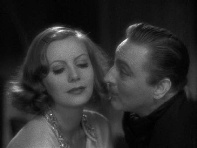
Grand Hotel has remained a favorite film for over five decades, but the reason for its continuing popularity is the glamorous presence of its stars. The cumulative charisma rather than their acting abilities. Greta Garbo's in particular, postures a great deal and overdoes the melancholia.
There are moments in the film that almost define movie stardom, especially John Barrymore's long love scene with Garbo. As they exchange passionate endearments, William Daniels's camera moves in for a close-up of the screen's two greatest profiles. This is MGM star-studded production in which she murmured the immortal line, “I want to be alone”
Grand Hotel was an enormous success under Irving Thalberg's aegis, but when he became hill in 1933,Mayer bought back David O. Selznick, who had worked briefly at MGM in the twenties as an associate producer.
“But I want to be alone”
What the Critics said:
The New Yorker
In spite of the brevity of her appearance, against what many a star would call ground odds, Garbo dominates the film entirely, making other players merely competent performers, in our opinion giving the tricky, clever film a lift, a spring, such as pictures without her, without that intense, nervous vitality she's got, cannot possess.
N.Y Herald Tribune
To foreigners intruding on cinema criticism the advice is hereby given, that if they don't like Miss Greta Garbo they'd better go back where they came from. “When in a strange land worship the Gods of the place, whatever they are.”
Vicki Baum, author of Grand Hotel, In Modern Screen
If I say that Greta Garbo as the dancer is much better than I expected, that's not of small consequence. For I expected the utmost. I expected that she'd be Greta Garbo and would have been enough! But this time she did more than unusual. She played, so to speak, two roles. First, the weary, lonely dancer, aching for success, and then the awakened woman experiencing a great love. I've always maintained that the ability to transform one's self constitutes great acting.
Here Garbo has achieved something, which few people expected of her. She has fitted herself into a play and into a cast, and has rendered a great performance exactly at that point where the role was contrary to her own being. The twittering, laughing, hopping about, in the tarlatan of a ballet skirt is certainly not what Garbo would have sought out as her role. But she accomplished it.
The dead tired face in the beginning, then that face in which, between laughter and tears, love awakens! That face full of fear when she waits for her beloved in vain. Unforgettable! Thank you Greta Garbo.

Greta Garbo never won an Academy Award,
although in 1954 she did received a special Oscar,
“For her unforgettable screen performances.”
|
| |
| QUEEN CHRISTINA 1933
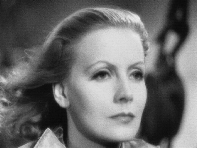
In 1933, Greta Garbo starred in one of her best films, playing Sweden's ambiguous Queen Christina under Rouben Mamoulian's direction. With John Gilbert as her personally requested costar, (she rejected Olivier). Garbo tossed history to the winds and transformed the allegedly plain-looking bisexual queen into a stunning woman who renounces her throne out of love for a man.
The film is a mixture of artful and tedious scenes, But its ending is legendary: aboard a ship carrying her and her dead lover back to Spain. Christina moves to the bow and the camera advances for an exceptionally long close-up of that immobile, inscrutable face. Mamoulian, in fact, had asked Garbo to make her face “a blank sheet of paper,” allowing every member of the audience to make his or her own interpretation.
Queen Christina was Garbo's twenty-first film and the first sound movie with John Gilbert, the once torrid combination in films. Gilbert's career had declined with the advent of sound, and legend has it that Garbo arranged for her former lover to be her costar. Garbo's assistance was to no avail. Gilbert made only one more film before he died of a heart attack and alcoholism in 1936. It was Gilbert's fourth and last film with her.
What the citics said:
The New Yorker
The Garbo film of the season, with the lady doing handsomely, though the story old Sweden sags a bit.
Modern Screen
Triumph for Garbo! One of the great pictures of the past few years, this historical epic makes a sustained drive for artistry. Besides, we have Garbo and Gilbert, very good indeed.
Photoplay
Garbo's as Sweden's stately sovereign of the seventeenth century! The magnificent Garbo, after an absence of over a year, makes a glorious reappearance on the screen. Garbo, enchanting as ever, is still enveloped by her unfathomable mystery.
|
| |
| CAMILLE 1937
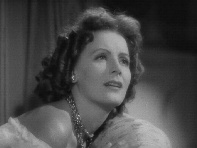
Garbo appeared in her most famous role, as Marguerite Gautier in Camille 1937. The story of the ill-fated courtesan had turned up in many versions since Alexandre Dumas wrote the play La Dame aux Camélias in 1852. MGM dusted off the slightly moth-eaten property, gave it a sumptuous if somewhat overstuffed production, put the fastidious George Cukor in charge of the direction, and starred Garbo as Marguerite, loving and coughing her way into legend.
To play her lover Armand, the studio chose Robert Taylor, young, inexperienced, Garbos love scenes with Taylor, are only minimally handicapped by his stiffness- she is so vibrant, so convincingly amorous that she all but electrifies the screen. In a memorable solo scene, after deciding to sacrifice her own happiness for Armand's sake, she weeps uncontrollably as she writes the Baron de Varville, (Henry Daniell) asking to return.
In the final death scene, Garbo succeeds in turning a clichéd character into a tragic figure, pale and drawn, but grasping at the last vestiges of hope. Camille was in the vein of high romance that most viewers found highly palatable during the thirties. “My heart! It's not used to being happy.” Her words in the last scene, she expires in Armand's harms, whispering, “Perhaps it's better if I live in your heart, where the world can't see me.” Those who would dispute Garbo's greatness as an actress should watch the changing emotions that pass across her face during this scene, or even the way she moves her failing body.
Camille may be a cluttered and musty monument to Garbo's art, but it is a monument, nonetheless.
For her performance in Camille, Garbo received a nomination for an Academy Award, the Litteris et Artibus Award from the King of Sweden, the Best Actress Award from New York Film Critics and a raise from MGM.
What the Critics Said:
New York Times
Greta Garbo's performance is in the finest tradition: eloquent, tragic, yet restrained. She is an incomparable in the role as legend tells us that Bernhardt was. It convinces that Camille is Garbo's best performance.
N.Y Herald Tribune
The incomparable Greta Garbo has returned to the screen in a breathtakingly beautiful and superbly modulated portrayal of Camille. As the tragic Dumas heroine, she floods a romantic museum piece with glamour and artistry, making it a haunting and moving photoplay by the sheer magic of her acting. Miss Garbo dignifies this latest of many presentations of Camille with a magnificent and unforgettable performance.
|
| |
| NINOTCHKA 1939
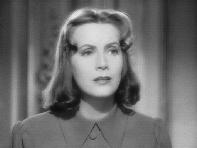
Lubitsch match the elegance and wit in 1939, when he directed one of his most celebrated films, Ninotchka. If this film is largely remembered for presenting Greta Garbo in her first romantic comedy, that is not to demean the screenplay by Charles Brackett, Billy Wilder, and Walter Reisch from a story by Melchior Lengyel. Witty and satirical, its story of the thawing of an austere lady Communist- an ex-sergeant in the Russian army, and her romance with a debonair Frenchman is as sparkling as the champagne she downs on a seductive evening in Paris.
Ninotchka pokes malicious fun at the Soviets: in the three nervous, impressionable Russians envoys who precede Ninotchka to Paris, in Ninotchka's severe clothing and somber demeanor, in jokes about trials and purges. The film is essentially a romance, as two people from widely divergent cultures move from attraction to devotion.
The melting of Ninotchka takes effect in a series of delightful sequences; like the one were an amorous Leon (Douglas) tries to make love to her. “Do you like me just a little?” she replies, “Your general appearance is not distasful.”
Later in a small café, she stubbornly resists Leon's attempts to make her laugh, until he accidentally tumbles from his chair and she roars with pleasure. The film ads shouted, Garbo Laughs!
It was Garbo's first American comedy role, and she gave an intelligent and truly funny performance, which earned her another nomination for an Academy Award. The film inspired Comrade X in 1940 and The Iron Petticoat in 1956, and Cole Porter used the story as basic for the Broadway musical Silk Stockings also filmed with Fred Astaire and Cid Charisse, in a magnificent Technicolor musical movie.
What the Critics said:
N.Y Herald Tribune
Now that she has done it, it seems incredible that Greta Garbo never appeared in a comedy before Ninotchka. Ernst Lubitsch has put his famous directional touch on the film and it is leavened with witty lines and deft characterizations, but it is memorable as well as entertaining for having disclosed new gifts in the First Actress of our days.
New York Times
Garbo's Ninotchka is one of the sprightliest comedies of the year, a gay and impertinent and malicious show which never pulls the punch lines (no matter how far below the belt they may land) and finds the screen's austere first lady of drama playing in deadpan comedy with assurance of a Buster Keaton…. It must be monotonous; this superb rightness of Garbo's playing. We almost wish she would handle a scene badly once in a while just to provide us with an opportunity to show we are not member of a fan club. But she remains infallible and Garbo, always exactly what the situation demands, always as fine as her script and director permit her to be.
Another Critic of the time declared,
"It is a joyous, subtly shaded and utterly enchanting portrayal which she creates, to illuminate a rather slight satire and make it the year's most captivating screen comedy.”
|
| |
| GARBO FILMS AND DIRECTORS

Garbo made twenty seven (27) films, her first a small Swedish – made film of 1922, Luffar-Petter and she was billed in the cast under her real name, Greta Gustafsson. But in 1924 was the beginning of Greta Garbo.
  
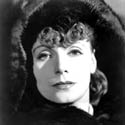  
The Story of Gosta Berlings - 1924
This was the beginning with her mentor Mauritz Stiller
The Street of Sorrow - 1925
Die Freudlose Gasse. G.W.Past
The Torrent- 1926
Her first American Film-Monta Bell
The Temptress - 1926
Fred Niblo Her mentor Stiller directed the Temptress at first.
Flesh and the Devil - 1927
Clarence Brown
Love - 1928
Edmund Goulding
The Divine Woman - 1928
Victor Seastrom - The Lost Film
The Mysterious Lady - 1928
directed by Fred Niblo
A Woman of Affairs - 1929
Clarence Brown
Wild Orchids - 1929
Sidney Franklin - during filming she received the news of Stiller's death
The Single Standard - 1929
John S. Robertson
The Kiss - 1929
Jacques Feyder was Garbo's last silent film
Anna Christie - 1930 Clarence Brown - she made also a German version.
Her first nomination for an Academy Award
Romance - 1930
Clarence Brown - a second nomination in a roll for Garbo
Inspiration - 1931
Clarence Brown
Susan Lenox: Her Fall and Rise - 1931
Robert Z. Leonard
Mata Hari - 1932
George Fitzmaurice - this film was release edited even the real version still exist,
they cut some dance sequence and a light neglille scene due to the censors of
those days. (no reason to censor and every reason to try). This was one of Garbo's
most profitable film in her career.
Grand Hotel – 1932
Edmund Goulding - Academy Award for Best Picture
As You Desire Me – 1932
George Fitzmaurice
Queen Christina – 1933
Rouben Mamoulian
The Painted Veil – 1934
Richard Boleslawski (this was a version on the real story re-make in 2006)
Anna Karenina – 1935
Clarence Brown a re-make of the silent Love from 1927
Camille – 1937
George Cukor Garbo's personal favorite. Garbo was nominated for An Academy Award
Conquest - 1937
Clarence Brown - this was Brown's six film directing Garbo and the last.
Ninotchka – 1939
Ernst Lubitsch Garbos first light comedy that earn her another Academy Award nomination
Two Faced Woman - 1941
George Cukor- Garbo's Swan Song and Cukor's second directing Garbo |
| |
GARBO'S SALARY AND PRESS STRATEGY

It started with William Daniels, the ace MGM cameraman, while making Flesh and the Devil with screen lover John Gilbert; Daniels introduced her to a nondescript, somewhat shy agent named Harry Edington.
Over dinner one evening at Gilbert's mansion, Edington listened to Greta's chronic complaints about her paycheck that was about $500 a week by that time, and her fear she had that her stardom would fade.
“You need an agent. Let me help you,” he said. Greta agreed and pleaded with Edington to deal with Mayer and Thalberg. “I don't like them, they don't like me,” she said bluntly. “You talk to them.”
A week later Edington met with Mayer and Thalberg in a three-hour session . “There's one thing I think will work,” Edington said.
“Since Greta can't deal with the press anyway, why don't we cut her off completely-from the press, the public, and even her fellow stars. We will fashion her into an unknown commodity. The less people know her the better. Nobody can resist that strategy.”
Edington even suggested a title - the woman of mystery.
Bingo! Greta Garbo vanished from the public eye of Hollywood . Edington scoured Beverly Hills and found a house as secluded as a Spanish nunnery. It had a walled garden and a private road sealed by a gatehouse. Even the studio wasn't given the address.
It was also Edington who devised the Garbo costume that prevails for long, even her whole life, gray and brown sack like clothes, a battered old hat that came from the MGM costume department, and dark glasses on the order of Gloria Swanson's rococo frames in Sunset Boulevard.
Within a year Greta Garbo had turned her private life into the greatest performance she would ever give.
There's absolutely no doubt about the chilly calculation that transformed Garbo into a lonely legend.
“Under the guidance of Edington and MGM loneliness became Garbo's most important product,” s aid Howard Dietz, Metro's New York publicity executive for three decades.
“The new, hidden Garbo is a hoax,” said by that time, Photoplay in an editorial . “This is simply another creation of the dream factories.”
Then, for an actress who prided herself on a disdain of the financial rewards and trappings of Hollywood , Greta did an incredible thing.
Since her two-year pact was drawing to an end (although MGM had options to hold her for several more years), she went to Mayer's office and told him she wished to go home.
“Six hundred dollars a week is insufficient,” she told Mayer. “Especially for a star of my standing.”
The speech reeked of calculation, probably Edington's.
“What would you consider?” Mayer asked. “Five thousand dollars a week will do,” she answered.
Mayer began screaming: “You ungrateful bitch,” he screamed , “Such a salary is out of the question. Just who do you think you are?”
“Greta Garbo!” She answered coolly. “Well, Miss Greta Garbo, I brought you to this country, gave you a chance to star in American films and built you into a star. And this is how you repay us.”
Garbo continued to stare over his head. She slowly pulled up out of the chair, turning her back on Mayer.
“Where the hell do you think you're going?” he said. “Home. To Sweden ,” she answered. “I thank I go home now” She was on the next boat.
As the months passed with no word from Greta, the MGM brass in New York panicked, discovering that they didn't even have her address. Reaching her through the U.S. Embassy in Stockholm they began a series of offers starting at $ 2,000 a week and, finally, over the groans and protestations of Mayer.
She was given $ 5,000 a week, plus the privilege of going home each day at 5 pm. It was a newer, slimmer Garbo who reported back to MGM.
The queen of the lot. Unfortunately, she had begun to believe her own publicity. The press depicted her as a lonely, melancholy personality, so she became just that. But maybe was a truth in it, Stiller wasn't no more, she became a real recluse.
|
| |
GRETA'S PARANOIA WHILE FILMING
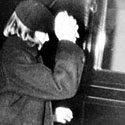
Is well know that Garbo's sound stage was sealed off with canvas and velvet at her request, and the help of her cameraman William Daniels. But Greta Garbo's paranoia increased over the years, and frequently imaged spies on the set when there were none.
“I know somebody is here, I can feel it,” she complained to Clarence Brown. “I assure you, Greta, there's nobody here.”
"I don't believe it. Turn on all the lights,” she demanded.
Not until the set was fully illuminated so that Greta could count each technician did she agree to continue the day's shot.
One afternoon a party from Washington was touring the studio as guests of Mayer. More than anything else they wanted to see Garbo.
An executive, with twenty-eight people waiting for him outside, came over to the actress and pleaded, “We can't keep these people standing outside.”
“All right, let them come in,” Garbo answered. “And I will go home.” The subject wasn't mentioned again.
|
| |
| |
| SOURCES
Marie Cahill - A Hollywood Portrait
Michael Conway - Parker Tyler - The Films of Greta Garbo
Ted Sennett - Great Hollywood Movies
Edited by Néstor G. Acevedo (GREG) |
| |
| |